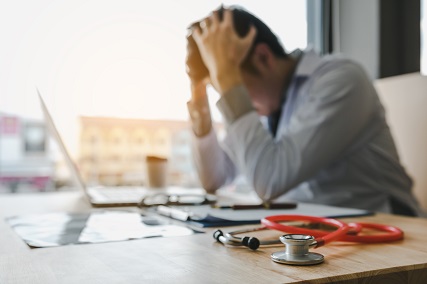
Fall 2020
Post-Traumatic Stress Disorder and Vicarious Trauma Among Healthcare Workers
Em V. Adams, PhD, CTRS✉; Violence and Trauma SIG

In pre-COVID-19 times an estimated 16% of emergency room physicians and 20-30%1 of nurses met the criteria for post-traumatic stress disorder (PTSD).2 Notably, rates of suicide among physicians was 40 times higher than the general population for male physicians and 130 times higher for female physicians.3
While we do not have data to report the impact of the global pandemic on these numbers, we can identify factors that may lead to increased risk of trauma, burnout, and suicide. These factors include witnessing numerous patient deaths, working with grieving families, being isolated, lack of personal protective equipment, and anxiety over personal health and the health of loved ones.4
For some, the risk of PTSD is heightened after the initial stressor has resolved. Physician, Wendy Dean wrote “My medical training taught me how to get through a crisis…My training did not teach me what the other side of those crises would look like, though, when the action of crisis was replaced by the stillness of recovery. There was no plan or contingency for when, in an unguarded moment, the door to my emotions blew open and the pent-up tsunami of grief and fear and sadness and anger and insecurity and doubt swept over me.”4 As parts of the country move into recovery, healthcare agencies need specific plans in place to ensure the safety and emotional well-being of healthcare workers. Outlined below are some suggestions for adding to a strategic plan to recover from trauma.
Create a culture of peer support. Teams should have an opportunity to debrief after a difficult crisis, and supervisors might consider implementing a buddy system so each person has someone checking on them.5 Clinical supervision should include opportunities to discuss personal feelings regarding difficult events. Additionally, managers can intentionally create other opportunities for peer support to occur.
Provide resources for workers to get psychological counseling. If your agency does not already have an affiliation agreement with a counseling center, help can be found on the following sites: Trauma Recovery Network https://www.emdrhap.org/content/trn/what-do-trn-associations-do/; Frontline Workers Counseling Program https://www.fwcp.org/
Make a strategic plan for rest and recovery. After natural disasters or deployment, there is typically a planned rest period before people are expected to move on to the next task. While there is not a clear end to COVID-19, there should be a strategic plan in place for ensuring employees get rest, vacation days, mental health days, and time to recover and seek treatment as desired should be a priority.5
Communicate resources outside of counseling. Pospos et al. conducted a literature review on available apps for preventing burnout and suicide for medical workers.6 The following apps were recommended based on the literature: Breath2Relax (breathwork) Headspace, guided meditation audios (mindfulness), MoodGYM, Stress Gym (web-based Cognitive Behavioral Therapy), and Stay Alive, Virtual Hope Box (suicide prevention apps). For some, apps may be a more accessible option for improved coping strategies in distressing moments.
In summary, those of us working in behavioral health may or may not be working at the forefront of the COVID-19 response. However, most of us have been impacted or have colleagues who have been impacted in profound ways. It’s up to all of us to create a culture that prioritizes well-being of all employees.
References
- Schernhammer ES. Taking Their Own Lives – The High Rate of Physician Suicide. N Eng J Med. 2005;352(24):2473–2476.
- Hosseininejad, S. M., Jahanian, F., Elyasi, F., Mokhtari, H., Koulaei, M. E., & Pashaei, S. M. (2019). The prevalence of post-traumatic stress disorder among emergency nurses: a cross sectional study in northern Iran. BioMedicine, 9(3).
- Kalmoe, M. C., Chapman, M. B., Gold, J. A., & Giedinghagen, A. M. (2019). Physician suicide: a call to action. Missouri medicine, 116(3), 211.
- Dean, W. (2020). Suicides of two health care workers hint at the Covid-19 mental health crisis to come. Stat News Retrieved from: https://www.statnews.com/2020/04/30/suicides-two-health-care-workers-hint-at-covid-19-mental-health-crisis-to-come/
- Substance Abuse and Mental Health Services Administration (2018) First Responders: Behavioral Health Concerns, Emergency Response, and Trauma. Supplemental Research Bulletin. Retrieved from: https://www.samhsa.gov/sites/default/files/dtac/supplementalresearchbulletin-firstresponders-may2018.pdf
- Pospos, S., Young, I. T., Downs, N., Iglewicz, A., Depp, C., Chen, J. Y.,& Zisook, S. (2018). Web-based tools and mobile applications to mitigate burnout, depression, and suicidality among healthcare students and professionals: a systematic review. Academic psychiatry, 42(1), 109-120.